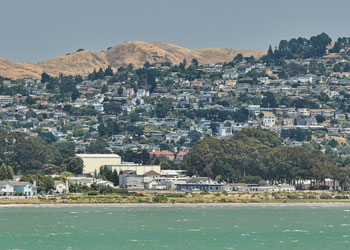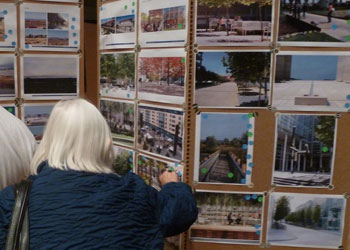Listening and learning, new partners plant seeds for Richmond Bay campus
More than 300 people turned out for a lively community workshop to start sketching out what will be the Richmond Bay Campus, a coveted prize for which the city competed with seven other Bay Area cities.

July 30, 2012
If a journey of a thousand miles begins with a single step, UC Berkeley, Lawrence Berkeley National Laboratory and the city of Richmond set out together Thursday night toward a glittering destination, the creation of a new joint campus on a dramatic stretch of university-owned land on the Richmond waterfront.

Future site of the Richmond Bay Campus, as seen from Brooks Island. Beyond lie the Richmond Annex, the city of El Cerrito and Wildcat Canyon. (Doug Lockhart photo)
More than 300 people turned out for a lively community workshop in the Richmond Memorial Auditorium to start sketching out what will be the Richmond Bay Campus, a coveted prize for which the city competed with seven other Bay Area cities.
To a community reeling under the weight of economic hard times, Richmond’s winning bid holds the promise of jobs, beautification and revitalization. To the Berkeley Lab, the second campus offers a way to consolidate research efforts scattered in small East Bay sites from Emeryville to Walnut Creek. To UC Berkeley, it will be a site where research innovation can flourish, and where the Lab and campus can continue to build on their already thriving partnership.
A receptive crowd — including staff from the offices of U.S. Rep. George Miller, state legislators Loni Hancock and Nancy Skinner, Contra Costa County Supervisor John Gioia, Mayor Gayle McLaughlin and Richmond councilmembers — explored the various facets of the proposed site at information tables at the back of the auditorium. (Among them: “Jobs and Business Opportunities,” “Education and Community Wellness” and “Planning and Community Input.”) At the “Site Character” table, many attendees took the opportunity to paste penny-sized dots on photos of architectural features they’d like to embellish their own shoreline.

A woman at Thursday’s workshop places a blue dot to indicate her preference in architectural features.
And they listened attentively to presentations from representatives of the Lab, UC Berkeley, and EHDD Architecture on topics ranging from sustainability and transportation to what was clearly uppermost in the minds of much of the audience, the prospect of new, well-paying jobs for the city’s residents.
As expected, the meeting brought more questions than answers. “Keep in mind,” advised Jeff Miller, the Lab’s public-affairs chief and workshop emcee, “that this is the beginning of a long process of public engagement.”
That set the tone for the evening, as speaker after speaker voiced a desire for community input, framing the ambitious project as a long-term partnership or, as Berkeley Associate Chancellor Linda Williams put it, “a unique opportunity for UC Berkeley and the Lab to strengthen our relationships with the Richmond community.”
Graham Fleming, the campus’s vice chancellor for research and a former deputy director at the Lab, noted that UC Berkeley and Richmond have been neighbors since 1950, when Berkeley purchased the current Richmond Field Station property. With the advent of the second campus, he said, “we are both the old kid and the new kid on the block.”
Berkeley’s hope, said Fleming, is that the new campus will foster “major discoveries” to address pressing challenges in the global economy, energy, the environment and human health, while bringing new economic activity and cultural and educational resources “to enrich the Richmond community.”
“We want the Richmond Bay Campus to be the place that produces the science for healthy living and sustainable communities,” he said, “but we are going to need your help and input in order to get there.”
“It takes time and investment to build a better future,” Fleming told the crowd, adding that one of Berkeley’s goals is to ensure that the new campus helps generate funding streams. But he expressed confidence that the campus, the Lab and the city “can build something truly special together.”
As laid out by Horst Simon, Berkeley Lab’s current deputy director, the journey toward a second campus will be “a long process,” with UC regents’ approval still needed for the site itself. Officials hope that a Long Range Development Plan can be completed by the end of 2013, and that construction of the first buildings — expected to house research in biosciences — can begin in 2014. If all goes smoothly, Lab staff would start moving in to the new facilities in 2017.
Architect Scott Shell, whose firm designed the Monterey Bay Aquarium and a new home for the Exploratorium in historic waterfront buildings on San Francisco’s Embarcadero, noted that the “spectacular site” for the campus “goes all the way down to the bay’s edge,” providing “sweeping panoramas” that take in the Bay Bridge and the San Francisco skyline. He offered a primer on building materials, colors, shapes, window types and even urban design — the way buildings can create commons, connect trails and augment the landscape. But he declined to state his own preferences, choosing instead to allow community members to identify features they’d most like to see.
“We don’t have answers,” said Shell. “We’re here to listen and learn from you.”
A second community meeting — this one to feature a dozen or so scientists, who will discuss the research planned for the Richmond Bay Campus — is scheduled for Thursday, Sept. 6.